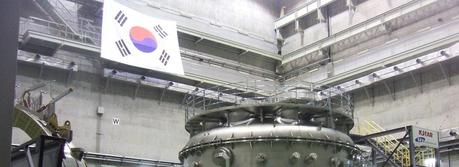
The KSTAR, or Korea Superconducting Tokamak Advanced Research is a magnetic fusion device being built at the National Fusion Research Institute in Daejon, South Korea. (Credit: Michel Maccagnan http://en.wikipedia.org/wiki/File:KSTAR_tokamak.jpg)
“Gap“ was a much-used word in a talk given by G.S. Lee on February 18 at EFDA in Garching, Germany. Lee, who had already helped establishing the South-Korean fusion programme, leads the country’s activities towards a demonstration fusion reactor DEMO. DEMO is the intermediate step between ITER and the advent of commercial fusion power. Most countries active in fusion research are starting plans for such a device. EFDA has outlined the European plans for DEMO in the recently published roadmap to the realisation of fusion energy.
In his presentation, Lee described the K-DEMO programme, which currently embarks on a pre-conceptual design study of conceptual design activities. “We must start to close the gap between ITER and DEMO or commercial fusion“ he pointed out “if we wait for ITER operation, we might lose momentum and about one decade in time.” K-DEMO is planned to be a steady-state operating, superconducting tokamak, also possibility for pulsed operation in an initial phase is not ruled out. Engineering design is to begin around 2022, two years after ITER takes up operation. K-DEMO construction is planned to start in 2027, the year ITER enters the deuterium-tritium stage. In its first phase, K-DEMO will serve as a test and qualification facility for materials and components. Electricity production is foreseen for the second phase, when K-DEMO is expected to deliver around 500 MW to the grid. “The proposed timeframe and the general strategy for K-DEMO is quite similar to the recently published EU Roadmap, which targets electricity production in the late 2040s, “ commented EFDA Leader Francesco Romanelli. Under the umbrella of EFDA, the European fusion research community started its DEMO activities about two years ago. Both, the European and the Korean DEMO programmes fully rely on ITER success and currently dedicate their utmost efforts to the ITER programme.
Lee came to EFDA to exchange some views with regards to DEMO design and R&D work. Materials development and development of heat exhaust concepts are potential areas of common interest, where in his view Europe has a leading position in his view.
“It is good to see several ITER partners starting with DEMO activities and I would expect increased momentum in that area now, “ said Gianfranco Federici, Head of the EFDA Power Plant Physics and Technology Department, who leads the European DEMO activities.
DEMO (DEMOnstration Power Plant) is a proposed nuclear fusion power plant that is intended to build upon the expected success of the ITER experimental nuclear fusion reactor. Whereas ITER’s goal is to produce 500 megawatts of fusion power for at least 500 seconds, the goal of DEMO will be to produce at least four times that much fusion power on a continual basis. Moreover, while ITER’s goal is to produce 10 times as much power as is required for breakeven, DEMO’s goal is to produce 25 times as much power. DEMO’s 2 to 4 gigawatts of thermal output will be on the scale of a modern electric power plant. Also notably, DEMO is intended to be the first fusion reactor to generate electrical power. Earlier experiments, such as ITER, merely dissipate the thermal power they produce into the atmosphere as steam.
To achieve its goals, DEMO must have linear dimensions about 15% larger than ITER and a plasma density about 30% greater than ITER. As a prototype commercial fusion reactor DEMO could make fusion energy available by 2033. Subsequent commercial fusion reactors could be built for nearly a quarter of the cost of DEMO if things go according to plan.

